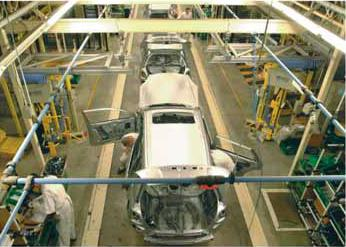HONDA CHOOSES ALUMINIUM PIPING
Two kilometer compressed air pipe work system for £130m car plant extension
Installation of almost two kilometers of compressed air pipe work vital to the very operation of a car assembly plant does not happen without a good deal of thought and forward planning.When leading automotive manufacturer Honda needed this quantity for the new £130m million extension to one of its major European production facilities, the project team chose Legris Transair pipe work system for its ability to meet a number of essential criteria. In addition to the need for cost efficiency, on time delivery and quality, Honda needed to know that the installer could work around other contractor on the site.The pipe work had to be assembled over the production lines at the same time that the lines themselves were going in. That required a system that could quickly be adapted as the other work was going on. Once installed, Honda needed to be able to change the system easily to meter future demands. Under those circumstances, traditional galvanized pipe work, with its need for threaded connection was not an attractive option.
VITAL
Compressed air is vital to automotive manufacturing and Honda relies heavily on a clean, plentiful supply where the new facility has increased available capacity to 250,000 automobile annually.Two compressors are in service at any one time in the new facility, driving up to 7,500 cfm of air through an eight-inch steel ring main suspended in the roof. Total compressor capacity on the site is in excess of 20,000 cfm.The task to supply the weld and assembly frame areas was to involve taking drops of 400mm Transair pipe work from the steel pipe to create sub ring mains directly over the production areas.
Speed of assembly, modification and
Interchangeability
were particularly relevant
Here, almost every operation relies on the use of compressed air power hand tools and 12 Transair sub ring mains were created, ranging from five to 120 meter in length. Transair is used to provide the vertical links from the steel ring main at roof level down to the horizontal sub ring mains. Here there strong, yet lightweight lengths of 40mm diameter aluminum pipe work are mounted on metal frames directly above the production lines which carry other services such as lighting and electricity. The number of drops to the lines ensures that every work station is well supplied with access to compressed air.
QUALITY
The quality of compressed air and the system that carries it are of major importance to Honda, Where- out of two shifts working an 18-hours day- the company allows itself downtime of just three minutes,. The air is filtered at each point where it flows from the steel ring main into the Transair system, with all filters incorporating pressure reducers.Honda’s search for a compressed air pipe work system to meet its demanding criteria ranged from investigation into traditional galvanized pipe work through the Transair Push-to-fit aluminum system.Technically, the only restriction other than flow rates was that the system had to be silicone-free because of the company’s paint processes.
BENEFITS
It was when the project team looked at Transair, however that it saw that far faster installation and modification offered benefits in both the short and long term.Visits to an existing user confirmed the system’s versatility and Transair was able to prove itself from the outset. Because of the various installation schedules, the Transair pipe work had to be erected over the production line area before those lines actually existed. This meant working over the deep tranches which were going to house the conveyors. The light weight of Transair enables the installers to carry out the operation easily, whereas the weight of galvanized pipe would undoubtedly have caused problemsAs Transair is the rapid-fit system, section could be disassembled and reassembled in a matter of minutes. And because the corrosion resistant aluminum tubing is already powder coated blue, there was also no requirement to paint it on site.While the original specification was based on a straight run of pipe work suspended from steel work at three meter, it was anticipated that numerous height adjustments and doglegs would have to be made to by-pass production equipment as it was installed. With Transair, the installation team was easily able to make those changes as the project proceeded
LIGHTWEIGHT
As the conveyor system had not been fitted when the pipe work was due to be installed, the team also had to work over the pits on elevated platform, but again, the lightweight nature of the pipe work and its push-to-fit connection made the operation simple. Once installed, the Transair system was tested using bottled nitrogen and found to be complete leak-free, primary distribution pipework pressure is 9br, and testing was carried out at 1.5 times that pressure to 13 bars. Although the pressure to the secondary fit Transair is reduced to 7 bar, it had to be assumed that the working pressure could be 9 bars to allow for regulator failure. Part of the project included training for Honda’s maintenance personnel to enable them to modify the Transair installation as required. Already the team has taken advantage of the product’s push-fit connection technology to rearrange some of the production areas and add to them. Car manufacturer rely on constant improvement, with continuous changes in production processes, for Honda, Transair has provided an added dimension, with Fast, low-cost modification of its compressed air pipe work to match these changes



